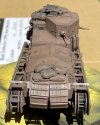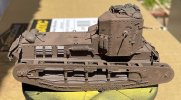Neon
Member
- Joined
- Nov 16, 2022
- Messages
- 22
Good evening everyone. I couldn't sit back and watch youtube videos any longer - I finally bought my first kit (Mk. A Whippet in 1:35 by Meng) and have been working on it. I finished the build without any major issues, but now I'm setting up to paint and I'm a little unsure about a few things. I airbrushed Mr. Finishing Surfacer 1500 (black) as the primer and thinned it 1:1 with Mr. Leveling Thinner 400. Everything went fine there. My question is about the next step. I pre-mixed some Tamiya acrylic paints into dropper bottles and thinned each mix with Tamiya Lacquer Thinner (orange cap). At the time I had it in my head that I had read somewhere the Tamiya paints mixed with the lacquer thinner was a good combo. The paints look fine in the dropper bottles, just as an aside.
Now I have some fear about spraying the primer with a lacquer-thinned paint. Am I setting myself up for an issue here, or am I just over thinking this business?
I appreciate any advice and/or feedback. Thank you.
Now I have some fear about spraying the primer with a lacquer-thinned paint. Am I setting myself up for an issue here, or am I just over thinking this business?
I appreciate any advice and/or feedback. Thank you.



